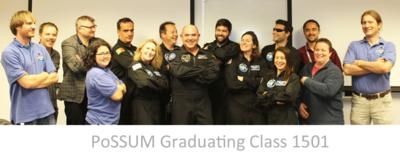First Manned Commercial Suborbital Research Program Graduates Have Mission To Study Global Climate
Project PoSSUM, a non-profit suborbital research project devoted to the study of our upper atmosphere, announced Monday that it had graduated its first class of Scientist-Astronauts. The PoSSUM Scientist-Astronaut Qualification Program, designed by former NASA astronaut instructors and hosted by the Embry-Riddle Aeronautical University in Daytona Beach, FL provides its candidates with the skills required to effectively conduct research on commercial space vehicles as part of an international research campaign dedicated to the study of global climate.

PoSSUM, an acronym for Polar Suborbital Science in the Upper Mesosphere, uses commercial suborbital spacecraft and high-altitude manned balloons to study rare “space clouds” called noctilucent clouds. These elusive clouds can help scientists address critical questions about the Earth’s climate, but they can only be seen from polar latitudes during a small window of time in the summer. The project evolved from the Noctilucent Cloud Imagery and Tomography experiment, selected by NASA’s Flight Opportunities Program in March 2012 as experiment 46-S.
The PoSSUM candidates learned about upper-atmospheric and noctilucent cloud science while participating in realistic mission simulations developed in partnership with Embry-Riddle. These simulations were designed to train candidates to effectively use PoSSUM imager systems and instrumentation to study noctilucent clouds in suborbital flight. In addition, candidates received comprehensive spacesuit training, high-altitude and hypoxia awareness training, and aerospace physiology training with world-champion aerobatic pilot Patty Wagstaff.
“This is an exciting time to be involved in spaceflight, and I feel very honored and fortunate to be a part of such a special opportunity. This represents the next step in evolution and eventual routine access to space for all, and while fulfilling the dream of my lifetime, I will be able to help make a significant difference in our world through this groundbreaking research opportunity,” said PoSSUM astronaut-candidate Pete Freeland.
Observing the inaugural PoSSUM program was Ecuadorian Cosmonaut Ronnie Nader, who will be modeling elements for their own national space program from the PoSSUM program.
“We have been incredibly pleased to see the enthusiasm generated by so many partners, sponsors, and participants that have committed themselves to enable and communicate the science integral to the PoSSUM mission,” said PoSSUM Principal Investigator Dr. Jason Reimuller.
“Fifty-six years ago, NASA announced the Mercury Seven, and today, we congratulate the PoSSUM Eight,” said Dr. Antonio Cortés, who oversees Embry-Riddle’s Commercial Space Operations degree and is the university’s liaison to the PoSSUM Scientist-Astronaut program. Dr. Cortés presented the PoSSUM graduates with certificates in Scientific Astronautics and contrasted the diverse backgrounds of the PoSSUM Eight to the Mercury Seven astronauts as a showcase of the new look of future human space flight.
The next PoSSUM scientist-astronaut class will occur at Embry-Riddle from October 10-14, 2015.
(ERAU Image. PoSSUM graduating Scientist-Astronaut candidates with Cosmonaut Ronnie Nader [center] and Principal Investigator Dr. Jason Reimuller [far right])
 NTSB Final Report: Cozy Cub
NTSB Final Report: Cozy Cub ANN FAQ: Contributing To Aero-TV
ANN FAQ: Contributing To Aero-TV Classic Aero-TV: Seated On The Edge Of Forever -- A PPC's Bird's Eye View
Classic Aero-TV: Seated On The Edge Of Forever -- A PPC's Bird's Eye View ANN's Daily Aero-Linx (04.29.25)
ANN's Daily Aero-Linx (04.29.25) ANN's Daily Aero-Term (04.29.25): Execute Missed Approach
ANN's Daily Aero-Term (04.29.25): Execute Missed Approach



